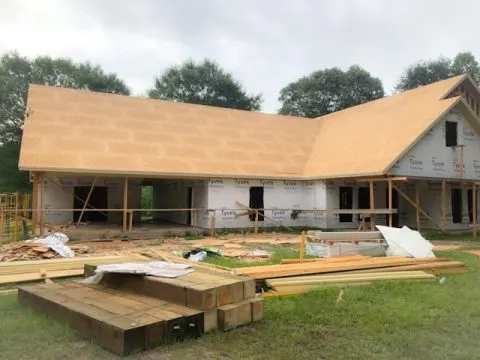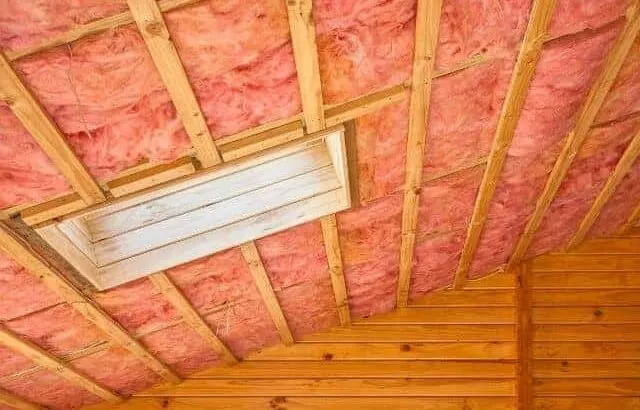When choosing insulation for your home, one of the most important factors to consider is whether it’s flammable. If you are considering batts, you must be wondering whether they are combustible.
Batt insulation made from fiberglass isn’t flammable, but the fiberglass will melt if the fire gets too hot. If the batt is covered with kraft paper or foil, though, these materials will burn, only melting the fiberglass. Batts with mineral wool will stand longer without melting.
If you want to know more about these materials and batt insulation in general as well as the main differences between fiberglass and mineral wool insulation and its flammability, read on.
Understanding Batt Insulation
Batt insulation is the most common kind of insulation, and it can be seen in many homes and commercial buildings. The two materials commonly used in batts are fiberglass and mineral wool, pre-cut into standard sizes (source).
Fiberglass insulation is often covered with kraft paper or foil. It is normally used in the areas which need a vapor barrier, although the vapor barrier can be installed separately, omitting the need for these materials (source).
For example, here’s my mother-in-law’s home during construction. A Tyvek vapor barrier was installed on the exterior of the home, a separate process from the insulation install. However, Tyvek is not flame resistant either (source).

When looking into batt insulation, one of the most important factors to consider is R-value, which shows how good the batts are at insulating your home. This value is often subject to local regulations when it comes to building.
Batts can be used for walls, ceilings, floors, and any other areas of your home or building where you might want insulation. If installed properly, the batts will an important component to creating an energy-efficient home.
Is Fiberglass Insulation Flammable?
Fiberglass is one of the most commonly used materials when it comes to batt insulation. The material itself is composed of glass fibers — the glass gets melted, and then those fibers are spun into what we know as fiberglass. The material itself has tiny holes as well.
On its own, fiberglass won’t burn. Even if the fire is near it, it won’t catch on fire. Although, if the temperatures get higher, the fiberglass will melt.
At the same time, if your fiberglass batts are covered in craft paper or foil, these materials will burn quickly, possibly causing more damage to the building.
Is Mineral Wool Insulation Flammable?
Mineral wool is another material that goes into insulation batts. It’s also known as rock wool, and it’s made similarly to fiberglass, with the main difference being that volcanic stone is melted instead of glass. It also contains recycled steel materials, which make it a very eco-friendly product (source).
Mineral wool is generally recommended as it will not catch on fire and it takes more time to melt it, making it a preferred choice for wooden constructions as well as metal constructions.
Mineral wool presents a safer solution since it will keep the construction in place for longer, while fiberglass will just melt, causing the walls to crumble faster.
So, the occupants of the home or anyone present in the burning building would have more time to leave it, and it will give more time for firefighters to deal with the fire without risking their safety.
Here’s a video that shows the flammability of different insulation materials and shows exactly how they react to heat and fire:
The Difference Between Mineral Wool and Fiberglass Batt Insulation
Here are the primary differences between mineral wood and fiberglass batt insulation.
| Fiberglass | Mineral Wool |
| Made with melted glass spun into a coherent mass | Made with molten volcanic rocks and recycled materials like steel and pressed into a coherent mass |
| R-value of 2.2 per inch of thickness | R-value of 3.3 per inch of thickness |
| Available in many different sizes | Sizes of batts not that varied |
| Less than 30% of its composition is recycled | 70% of its composition is recycled |
| Fiberglass is a cheaper form of insulation | Mineral wool batts cost more |
| Harder to install because it flops over | Firm and easy to install (stays in place) |
| Absorbs water easily, gets soggy, and could develop mold, fungi, etc. | Doesn’t absorb water at all |
| Not combustible but will melt at higher temperatures – kraft paper and foil facing used often with fiberglass are combustible | Not combustible and will not melt easily, even at higher temperatures – used as a firestop often |
How They Are Made
Fiberglass is the more popular form of insulation. As mentioned, it’s made by melting glass and then spinning those fibers into a coherent mass that might remind you of cotton candy.
However, this is not the main reason that fiberglass is so popular — the main cause of this is the affordability, variety of options, and the fact that fiberglass is a pretty good insulator.
Mineral wool is a newer material that also comes in batts. But, mineral wool is not made of glass, but rather of volcanic rocks that are melted at high temperatures and spun similarly to fiberglass.
This material is then compressed into these dense panels, which are the size and cut into appropriate batts.
R-Value
The first thing to look at when choosing between mineral wool and fiberglass is their R-value or insulation ability. While fiberglass has an R-value of 2.2 per inch of thickness of the material, mineral wool ranks a bit better with the R-value of 3.3.
Sizes, Cost, and Eco-Friendliness
At the same time, fiberglass comes in many different sizes, while mineral wool batts are not that varied. When it comes to sustainability, mineral wool ranks better as almost 70% of its composition is recycled, while fiberglass commonly has around 30% of recycled materials.
One clear advantage fiberglass has over mineral wool is its cost. Fiberglass is generally cheaper, which is why most people go for it over mineral wool.
At the same time, you have to take into account the better safety mineral wool gives you in case of a fire, and the fact that it is better at soundproofing than fiberglass.
Installation and Use
Mineral wool batts are generally heavier and easier to install because they are stiff and stay in place for longer. Fiberglass tends to be limp, although it is lighter. Because mineral wool is so stiff, it can be pressed into place, while fiberglass will have to be stapled or held with wires.
Mineral wool is resistant to fire and water as well. It won’t absorb any, meaning that you will be safe against fungi, and other issues that moisture can cause, thus preventing any damage to your construction as well.
Fiberglass, unfortunately, gets very soggy in contact with water, and it will not insulate well in this case.
Again, when looking at the fire resistance of both of these materials, it becomes clear that fiberglass has a disadvantage because it will melt sooner. At the same time, mineral wool can even be used to stop fires, so it’s a good choice if you live in a risky area when it comes to fires.
People often combine these two to get the best of both worlds. They put fiberglass in the areas where there’s a low chance of fire or where they need more insulation as fiberglass is less expensive.
Mineral wool would serve to cover the areas where the fire is more likely to happen and where the fire needs to be stopped.
Both of these materials are good insulators, so having both and properly installed will give you more benefits.
The good news is that neither of them is combustible if they don’t include a paper vapor barrier. It’s just the difference in the melting temperatures.
If you ask a professional, they may be able to tell you where you would need mineral wool as a firestop and where fiberglass would do.
Conclusion
While neither fiberglass nor mineral wool batts are combustible, there are certain things to consider. For example, how quickly either of the materials will melt. This can give you a pretty good idea of how they would perform in an emergency.
Keep in mind that with fiberglass batts that use facing foil or kraft paper, those components are flammable, even if the insulation itself is not.
Consider the idea of using both mineral wool and fiberglass batts as your ideal solution. That way, you will get the best of both worlds — the economic value of fiberglass and the highly efficient and fire-resistant mineral wool properties.
For more information, read Can Fiberglass Insulation Catch Fire? Know The Facts
As a homeowner, I am constantly experimenting with making the structure of my house more energy-efficient, eliminating pests, and taking on DIY home improvement projects. Over the past two decades, my family has rehabbed houses and contracted new home builds and I’ve learned a lot along the way. I share my hard-learned lessons so that you can save time and money by not repeating my mistakes.


Leave a comment
You must be logged in to post a comment.